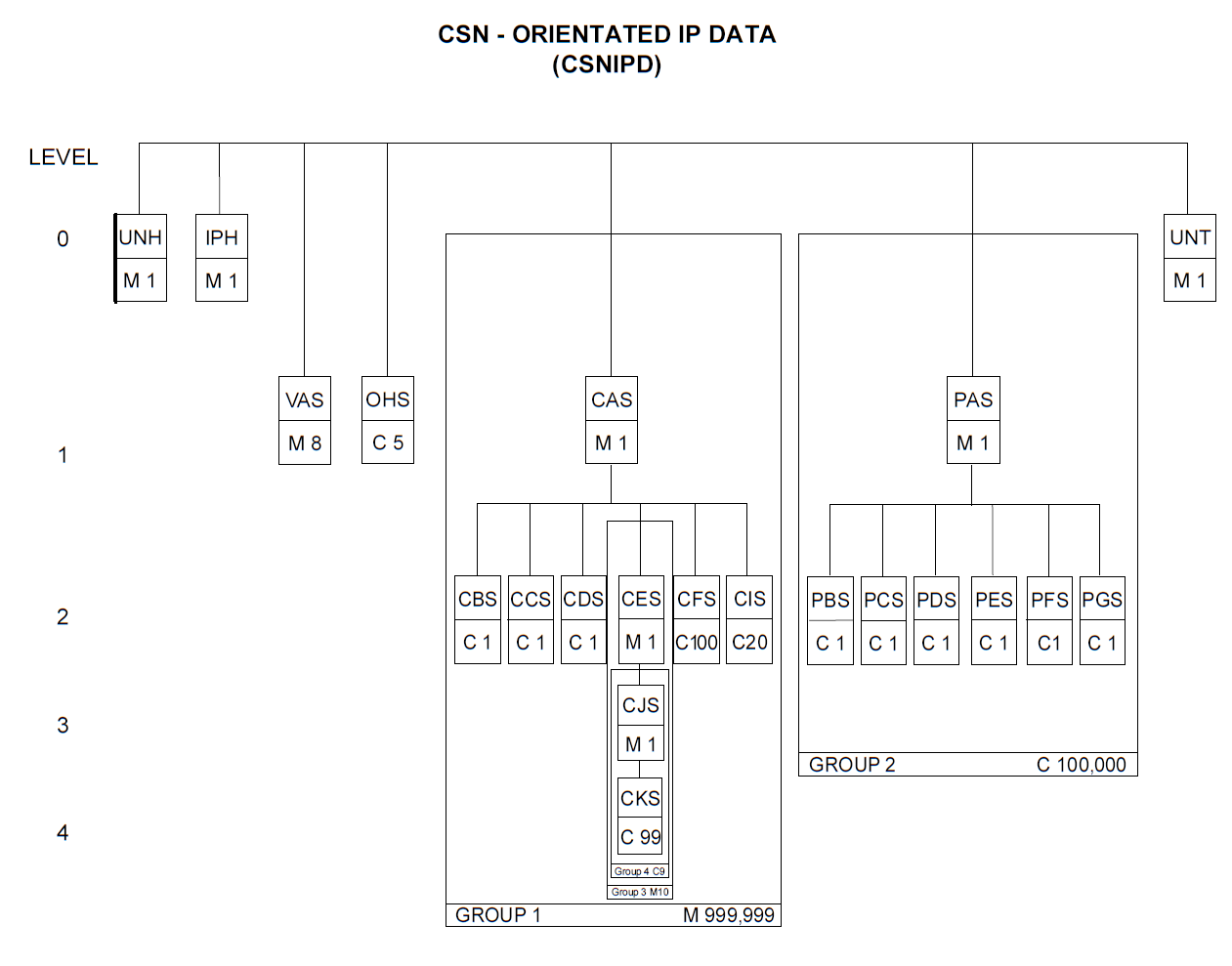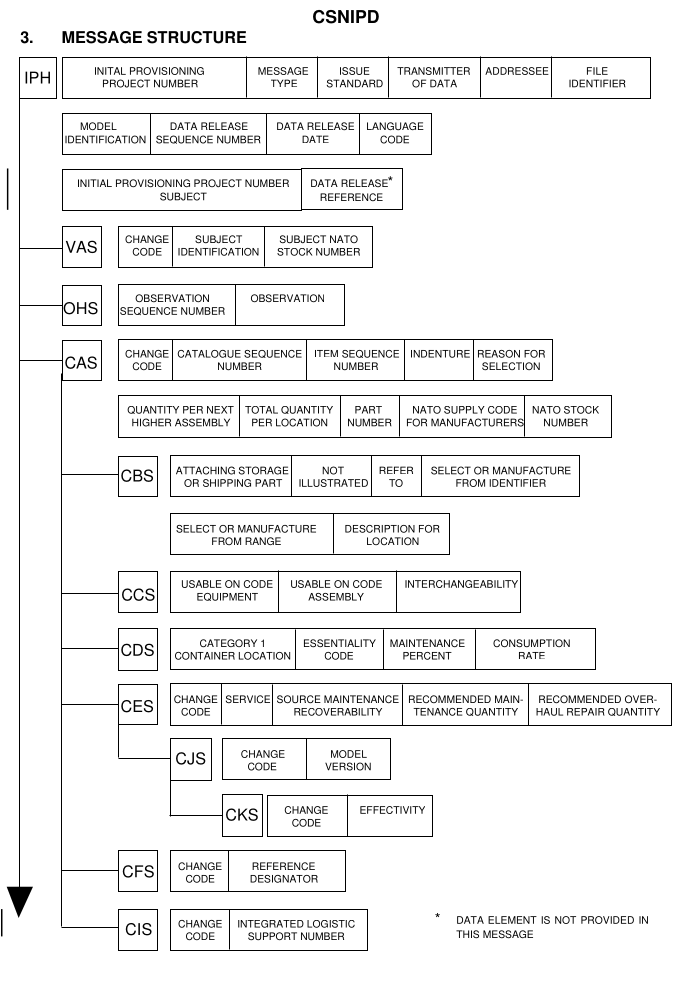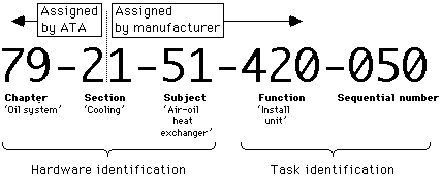S2000M Grammar Considerations
It turns out that while expressing the S2000M message formats as iXML grammars is
a lot of work, it's perfectly doable. Here's a made-up S2000M
CSNIPD (used for the transmission of IP data which
has been compiled in accordance with the CSN-orientated IP procedure
)
example:
UNH+123456+CD3456:EF1:FD3:C1:ABC123+1234567890ABCDEFGHIJ012345678912345+12:C'
IPH+IPP:F61170026+MTP:CSNIPD+ISS:D1+TOD:F6117+ADD:D1234+FID:S+MOI:1X+DRS:004+DRD:201088+LGE:UK+IPS:LANDING GEAR ASSY+DRR:AB123456'
VAS+CHG:N+SID:12345:X1234999999999999+SNS:1234:123456789'
OHS+OSN:1+OBS:TESTING THIS'
CAS+CHG:B+CSN:0123456789123+ISN:ABC+IND:9+RFS:0+QNA:123+TQL:ABCDE+PNR:01234567890+MFC:QWERT+NSN:1234:123456789'
CBS+ASP:1+NIL:Q+RTX:1234567890123456+SMF:X+MFM:THIS IS TEXT+DFL:THIS IS MORE TEXT'
CCS+UCE:ABCDEFGH+UCA:123456+ICY:AB'
CDS+CTL:1234567+ESC:9+MAP:12+CSR:321'
CES+CHG:A+SRV:ABC+SMR:654321+RMQ:12345+ROQ:98765'
CJS+CHG:C+MOV:BA'
CKS+CHG:D+EFY:ABCDEFGH'
CFS+CHG:A+RFD:1234567'
CIS+CHG:B+ILS:09876543211234567890'
PAS+CHG:F+PNR:123456789123456789123456789+MFC:EDCBA+DFP:THIS IS A DFP TEXT+INC:12345+NSN:1234:123456789+RNC:7+RNV:5+RNJ:3'
PBS+UOI:AB+SPQ:0123+TOP:QW+ITY:ER+SPC:0+PLT:12+STR:9+SLC:X+PLC:Y+PCD:W'
PCS+UOM:AB+QUI:1234'
PDS+UPR:123456789012+CUR:ABC+MSQ:54321+PBD:1:2:3000:4:5:11111111'
PES+CRT:123+SRA:21+MTI:123456:AB+TBI:123456:CD+TSI:654321:BD+ALI:987654:XY+TLF:123'
PFS+DMC:ABC123+HAZ:ED12+PIC:8+FTC:X+PSC:Q+ESD:0+CMK:9'
PGS+SUU:AB345678901234+SPU:CD345678901234+WUU:AB34567+WPU:CD34567'
UNT+123456+ABCD1234567812'
Much of this won't make sense to you, but we can spot the basic constructs, namely
segments —the rows starting with a three-letter alphabetic code followed by
+ and ending with a segment end character ('). Within
the segments, we can recognise data units, each separated with a plus
(+) and starting with a TEI (Text Element Identifier) followed by
one or more values, each separated with colons (':). The specification
defines the allowed contents for each segment and their respective data units (see
Figure 2
for an overview), and so the remaining work is about expressing those contents in
a
formal grammar.
Many segments are optional, as are many of the contained data units.
When they are optional depends on the type of information
being carried across by the messages, so some segments will only appear depending
of
the item being described or if other segments are used.
Figure 2 may
help illustrate this. The CAS segment provides mandatory
location-related information about the item, but the C
segments
CBS, CCS, CDS and CFS that
follow are only provided depending on the nature of the item. Those segments are
effectively child segments to CAS and do not appear without it. S2000M
does not define such a concept, but it is helpful to think of them in that
way.
{
This is an iXML grammar for S2000M CSNIPD messages.
S2000M spec 2.1: https://www.s2000m.org/S2000M/S2000M%20Issue%202.1%20CP1-4.pdf
iXML information: https://invisiblexml.org/
Grammar tested with https://johnlumley.github.io/jwiXML.xhtml
}
CSNIPD = UNH, IPH, VAS+, OHS*, CAS+, PAS*, UNT .
@segend = -"'", (#9 | #a0 | #a | #d)* .
-sep = -"+" .
-comp-sep = -":" .
-alpha = [L] .
-num = [N] .
-other-level-a = [" !.,(;&<>%*=)"; #22] .
-an = (alpha | num | other-level-a) .
-num4 = num, num, num, num .
-num9 = num, num, num, num, num, num, num, num, num .
-num0-2 = (num? | num, num) .
-num0-3 = (...) .
-num0-4 = (...) .
-num0-5 = (...) .
-num0-6 = (...) .
-num0-12 = (...) .
-an2 = an, an .
-an3 = an, an, an .
-an4 = (...) .
-an5 = (...) .
-an6 = (...) .
-an7 = (...) .
-an8 = (...) .
-an9 = (...) .
-an13 = (...) .
-an14 = (...) .
-an0-2 = (an? | an, an) .
-an0-3 = (...) .
-an0-4 = (...) .
-an0-5 = (...) .
-an0-6 = (...) .
-an0-7 = (...) .
-an0-8 = (...) .
-an0-14 = (...) .
-an0-16 = (...) .
-an0-19 = (...) .
-an0-20 = (...) .
-an0-32 = (...) .
-an0-35 = (...) .
no-segments-0074 = num0-6 .
msg-no-0062 = an0-14 .
msg-type-0065 = an0-6 .
msg-version-nbr-0052 = an0-3 .
msg-rel-nbr-0054 = an0-3 .
ctrl-agency-0051 = an0-2 .
assoc-assign-code-0057 = an0-6 .
message-identifier-S009 = msg-type-0065, comp-sep, msg-version-nbr-0052, comp-sep, msg-rel-nbr-0054, comp-sep, ctrl-agency-0051, comp-sep, assoc-assign-code-0057? .
common-access-ref-0068 = an0-35 .
sequence-transfers-0070 = num0-2 .
first-last-transfer-0073 = alpha . {C or F - should it be checked here?}
transfer-status-S010 = sequence-transfers-0070, comp-sep, first-last-transfer-0073 .
UNH = -"UNH", sep, msg-no-0062, sep, message-identifier-S009, sep, common-access-ref-0068, sep, transfer-status-S010, segend .
UNT = -"UNT", sep, no-segments-0074, sep, msg-no-0062, segend .
IPP = -"IPP", comp-sep, an9 .
MTP = -"MTP", comp-sep, an0-6 .
ISS = -"ISS", comp-sep, an, an .
TOD = -"TOD", comp-sep, an5 .
ADD = -"ADD", comp-sep, an5 .
FID = -"FID", comp-sep, alpha .
MOI = -"MOI", comp-sep, an, an .
DRS = -"DRS", comp-sep, num, num, num .
DRD = -"DRD", comp-sep, num, num, num, num, num, num .
LGE = -"LGE", comp-sep, alpha, alpha .
IPS = -"IPS", comp-sep, an0-19 .
DRR = "DRR", comp-sep, an8 .
IPH = -"IPH", sep, IPP, sep, MTP, (sep, ISS)?, sep, TOD, sep, ADD, sep, FID, sep, MOI, sep, DRS, sep, DRD, sep, LGE, sep, IPS, (sep, DRR)?, segend .
CHG = -"CHG", comp-sep, alpha .
mfc = an5 .
pnr = an0-32 .
SID = -"SID", comp-sep, mfc, comp-sep, pnr .
nsc = num4 .
nin = num9 .
SNS = -"SNS", (comp-sep, nsc)?, (comp-sep, nin)? .
VAS = -"VAS", sep, CHG, sep, SID, (sep, SNS)?, segend .
OSN = -"OSN", comp-sep, num .
OBS = -"OBS", comp-sep, an* . {This is 0-130 chars}
OHS = -"OHS", sep, OSN, sep, OBS, segend .
CSN = -"CSN", comp-sep, an13 .
ISN = -"ISN", comp-sep, an3 .
IND = -"IND", comp-sep, num .
RFS = -"RFS", comp-sep, num .
QNA = -"QNA", comp-sep, an0-4 .
TQL = -"TQL", comp-sep, an0-5 .
PNR = -"PNR", comp-sep, -pnr .
MFC = -"MFC", comp-sep, -mfc .
NSN = -"NSN", comp-sep, nsc, (comp-sep, nin)? .
CAS = -"CAS", sep, CHG, sep, CSN, sep, ISN, (sep, IND)?, (sep, RFS)?, (sep, QNA)?, (sep, TQL)?, (sep, PNR)?, (sep, MFC)?, (sep, NSN)?, segend, (CBS?, CCS?, CDS?, CES, CFS?, CIS?)? .
ASP = -"ASP", comp-sep, num .
NIL = -"NIL", comp-sep, an .
RTX = -"RTX", comp-sep, an0-16 .
SMF = -"SMF", comp-sep, alpha .
MFM = -"MFM", comp-sep, an* {0-40 alphanumeric chars} .
DFL = -"DFL", comp-sep, an* {0-130 alphanumeric chars} .
CBS = -"CBS", (sep, ASP)?, (sep, NIL)?, (sep, RTX)?, (sep, SMF)?, (sep, MFM)?, (sep, DFL)?, segend .
UCE = -"UCE", comp-sep, an8 .
UCA = -"UCA", comp-sep, an6 .
ICY = -"ICY", comp-sep, an, an .
CCS = -"CCS", (sep, UCE)?, (sep, UCA)?, (sep, ICY)?, segend .
CTL = -"CTL", comp-sep, an7 .
ESC = -"ESC", comp-sep, num .
MAP = -"MAP", comp-sep, num0-2 .
CSR = -"CSR", comp-sep, num0-3 .
CDS = -"CDS", (sep, CTL)?, (sep, ESC)?, (sep, MAP)?, (sep, CSR)?, segend .
SRV = -"SRV", comp-sep, an0-3 .
SMR = -"SMR", comp-sep, an0-6 .
RMQ = -"RMQ", comp-sep, num0-5 .
ROQ = -"ROQ", comp-sep, num0-5 .
CES = -"CES", sep, CHG, sep, SRV, (sep, SMR)?, (sep, RMQ)?, (sep, ROQ)?, segend, CJS* .
RFD = -"RFD", comp-sep, an0-7 .
CFS = -"CFS", sep, CHG, sep, RFD, segend .
ILS = -"ILS", comp-sep, an0-20 .
CIS = -"CIS", sep, CHG, sep, ILS, segend .
MOV = -"MOV", comp-sep, an0-2 .
CJS = -"CJS", sep, CHG, sep, MOV, segend, CKS* .
EFY = -"EFY", comp-sep, an0-8 .
CKS = -"CKS", sep, CHG, sep, EFY, segend .
DFP = -"DFP", comp-sep, an* {0-130 alphanumeric} .
INC = -"INC", comp-sep, an5 .
RNC = -"RNC", comp-sep, an .
RNV = -"RNV", comp-sep, num .
RNJ = -"RNJ", comp-sep, num .
PAS = -"PAS", sep, CHG, sep, PNR, sep, MFC, (sep, DFP)?, (sep, INC)?, (sep, NSN)?, (sep, RNC)?, (sep, RNV)?, (sep, RNJ)?, segend, (PBS?, PCS?, PDS?, PES?, PFS?, PGS?)? .
UOI = -"UOI", comp-sep, alpha, alpha .
SPQ = -"SPQ", comp-sep, num0-4 .
TOP = -"TOP", comp-sep, an2 .
ITY = -"ITY", comp-sep, an2 .
SPC = -"SPC", comp-sep, num .
PLT = -"PLT", comp-sep, num0-2 .
STR = -"STR", comp-sep, num .
SLC = -"SLC", comp-sep, an .
PLC = -"PLC", comp-sep, an .
PCD = -"PCD", comp-sep, an0-2 .
PBS = -"PBS", (sep, UOI)?, (sep, SPQ)?, (sep, TOP)?, (sep, ITY)?, (sep, SPC)?, (sep, PLT)?, (sep, STR)?, (sep, SLC)?, (sep, PLC)?, (sep, PCD)?, segend .
UOM = -"UOM", comp-sep, an2 .
QUI = -"QUI", comp-sep, num0-4 .
PCS = -"PCS", (sep, UOM)?, (sep, QUI)?, segend .
UPR = -"UPR", comp-sep, num0-12 .
CUR = -"CUR", comp-sep, alpha, alpha, alpha .
MSQ = -"MSQ", comp-sep, num0-5 .
qty = num0-5 .
upr = num0-12 .
PBD = -"PBD", comp-sep, qty, comp-sep, qty, comp-sep, upr, (comp-sep, qty, comp-sep, qty, comp-sep, upr)* {0-2 repetitions} .
PDS = -"PDS", (sep, UPR)?, (sep, CUR)?, (sep, MSQ)?, (sep, PBD)?, segend .
CRT = -"CRT", comp-sep, num0-3 .
SRA = -"SRA", comp-sep, num0-2 .
-alpha0-2 = (alpha? | alpha, alpha) .
tbf = num0-6 .
tcm = alpha0-2 .
MTI = -"MTI", (comp-sep, tbf)?, (comp-sep, tcm)? .
tbo = num0-6 .
tco = alpha0-2 .
TBI = -"TBI", (comp-sep, tbo)?, (comp-sep, tco)? .
tsv = num0-6 .
tcs = alpha0-2 .
TSI = -"TSI", (comp-sep, tsv)?, (comp-sep, tcs)? .
aul = num0-6 .
tca = alpha0-2 .
ALI = -"ALI", (comp-sep, aul)?, (comp-sep, tca)? .
TLF = -"TLF", comp-sep, num0-3 .
PES = -"PES", (sep, CRT)?, (sep, SRA)?, (sep, MTI)?, (sep, TBI)?, (sep, TSI)?, (sep, ALI)?, (sep, TLF)?, segend .
DMC = -"DMC", comp-sep, an0-6 .
HAZ = -"HAZ", comp-sep, an4 .
PIC = -"PIC", comp-sep, num .
FTC = -"FTC", comp-sep, an .
PSC = -"PSC", comp-sep, an .
ESD = -"ESD", comp-sep, num .
CMK = -"CMK", comp-sep, num .
PFS = -"PFS", (sep, DMC)?, (sep, HAZ)?, (sep, PIC)?, (sep, FTC)?, (sep, PSC)?, (sep, ESD)?, (sep, CMK)?, segend .
SUU = -"SUU", comp-sep, an14 .
SPU = -"SPU", comp-sep, an14 .
WUU = -"WUU", comp-sep, an7 .
WPU = -"WPU", comp-sep, an7 .
PGS = -"PGS", (sep, SUU)?, (sep, SPU)?, (sep, WUU)?, (sep, WPU)?, segend .The XML serialisation is as follows:
<CSNIPD>
<UNH segend=" ">
<msg-no-0062>123456</msg-no-0062>
<message-identifier-S009>
<msg-type-0065>CD3456</msg-type-0065>
<msg-version-nbr-0052>EF1</msg-version-nbr-0052>
<msg-rel-nbr-0054>FD3</msg-rel-nbr-0054>
<ctrl-agency-0051>C1</ctrl-agency-0051>
<assoc-assign-code-0057>ABC123</assoc-assign-code-0057>
</message-identifier-S009>
<common-access-ref-0068>1234567890ABCDEFGHIJ012345678912345</common-access-ref-0068>
<transfer-status-S010>
<sequence-transfers-0070>12</sequence-transfers-0070>
<first-last-transfer-0073>C</first-last-transfer-0073>
</transfer-status-S010>
</UNH>
<IPH segend=" ">
<IPP>F61170026</IPP>
<MTP>CSNIPD</MTP>
<ISS>D1</ISS>
<TOD>F6117</TOD>
<ADD>D1234</ADD>
<FID>S</FID>
<MOI>1X</MOI>
<DRS>004</DRS>
<DRD>201088</DRD>
<LGE>UK</LGE>
<IPS>LANDING GEAR ASSY</IPS>
<DRR>DRRAB123456</DRR>
</IPH>
<VAS segend=" ">
<CHG>N</CHG>
<SID>
<mfc>12345</mfc>
<pnr>X1234999999999999</pnr>
</SID>
<SNS>
<nsc>1234</nsc>
<nin>123456789</nin>
</SNS>
</VAS>
<OHS segend=" ">
<OSN>1</OSN>
<OBS>TESTING THIS</OBS>
</OHS>
<CAS segend=" ">
<CHG>B</CHG>
<CSN>0123456789123</CSN>
<ISN>ABC</ISN>
<IND>9</IND>
<RFS>0</RFS>
<QNA>123</QNA>
<TQL>ABCDE</TQL>
<PNR>01234567890</PNR>
<MFC>QWERT</MFC>
<NSN>
<nsc>1234</nsc>
<nin>123456789</nin>
</NSN>
<CBS segend=" ">
<ASP>1</ASP>
<NIL>Q</NIL>
<RTX>1234567890123456</RTX>
<SMF>X</SMF>
<MFM>THIS IS TEXT</MFM>
<DFL>THIS IS MORE TEXT</DFL>
</CBS>
<CCS segend=" ">
<UCE>ABCDEFGH</UCE>
<UCA>123456</UCA>
<ICY>AB</ICY>
</CCS>
<CDS segend=" ">
<CTL>1234567</CTL>
<ESC>9</ESC>
<MAP>12</MAP>
<CSR>321</CSR>
</CDS>
<CES segend=" ">
<CHG>A</CHG>
<SRV>ABC</SRV>
<SMR>654321</SMR>
<RMQ>12345</RMQ>
<ROQ>98765</ROQ>
<CJS segend=" ">
<CHG>C</CHG>
<MOV>BA</MOV>
<CKS segend=" ">
<CHG>D</CHG>
<EFY>ABCDEFGH</EFY>
</CKS>
</CJS>
</CES>
<CFS segend=" ">
<CHG>A</CHG>
<RFD>1234567</RFD>
</CFS>
<CIS segend=" ">
<CHG>B</CHG>
<ILS>09876543211234567890</ILS>
</CIS>
</CAS>
<PAS segend=" ">
<CHG>F</CHG>
<PNR>123456789123456789123456789</PNR>
<MFC>EDCBA</MFC>
<DFP>THIS IS A DFP TEXT</DFP>
<INC>12345</INC>
<NSN>
<nsc>1234</nsc>
<nin>123456789</nin>
</NSN>
<RNC>7</RNC>
<RNV>5</RNV>
<RNJ>3</RNJ>
<PBS segend=" ">
<UOI>AB</UOI>
<SPQ>0123</SPQ>
<TOP>QW</TOP>
<ITY>ER</ITY>
<SPC>0</SPC>
<PLT>12</PLT>
<STR>9</STR>
<SLC>X</SLC>
<PLC>Y</PLC>
<PCD>W</PCD>
</PBS>
<PCS segend=" ">
<UOM>AB</UOM>
<QUI>1234</QUI>
</PCS>
<PDS segend=" ">
<UPR>123456789012</UPR>
<CUR>ABC</CUR>
<MSQ>54321</MSQ>
<PBD>
<qty>1</qty>
<qty>2</qty>
<upr>3000</upr>
<qty>4</qty>
<qty>5</qty>
<upr>11111111</upr>
</PBD>
</PDS>
<PES segend=" ">
<CRT>123</CRT>
<SRA>21</SRA>
<MTI>
<tbf>123456</tbf>
<tcm>AB</tcm>
</MTI>
<TBI>
<tbo>123456</tbo>
<tco>CD</tco>
</TBI>
<TSI>
<tsv>654321</tsv>
<tcs>BD</tcs>
</TSI>
<ALI>
<aul>987654</aul>
<tca>XY</tca>
</ALI>
<TLF>123</TLF>
</PES>
<PFS segend=" ">
<DMC>ABC123</DMC>
<HAZ>ED12</HAZ>
<PIC>8</PIC>
<FTC>X</FTC>
<PSC>Q</PSC>
<ESD>0</ESD>
<CMK>9</CMK>
</PFS>
<PGS segend=" ">
<SUU>AB345678901234</SUU>
<SPU>CD345678901234</SPU>
<WUU>AB34567</WUU>
<WPU>CD34567</WPU>
</PGS>
</PAS>
<UNT segend="">
<no-segments-0074>123456</no-segments-0074>
<msg-no-0062>ABCD1234567812</msg-no-0062>
</UNT>
</CSNIPD>Notable in the XML are a few handy tweaks. For example, every segment — remember
the constructs starting with a segment name (tag
) and ending with an
apostrophe? — has a @segend attribute, making it easy to differentiate
between segments and data units. A composite data unit's components are named and, just as declared in
the specification, use lower-case letters.
Note
An earlier version of the grammar added an explicit notion of child segments,
and there was also grouping based on the multiple groups
described by the specification, but I've since removed them, based on end user
input.
All this becomes useful later, when publishing the XML in S2000M format (see section “Input and Output”).
Lengthy Productions
You'll notice in the CSNIPD grammar that I've edited some of the productions
to only contain ... rather than the full model. The problem is that
if I am to express a model such as 0 to 3 numeric characters, the iXML grammar
rules will have me do this (here, n represents a production
defining a single digit):
n0-3 = (n? | n, n | n, n, n ) .
A production defining a range between 0 and 130 numerical characters will be
quite a bit longer. Obviously, you can define a production using something like exactly
10 characters and then repeat that production where you need it:
n10 = n, n, n, n, n, n, n, n, n, n .
The result will still be a fair number of lengthy productions.
Syntactic Sugar
You'll notice that some productions begin with a - sign:
-an0-2 = (an? | an, an) .
Others include a - sign before a literal string (CHG
within quotes, right after the equal sign):
CHG = -"CHG", comp-sep, alpha .
This means that the XML serialisations should not output the production or
literal as elements.
Data Types
The S2000M 2.1 specification made it obvious that memory was precious, 30
years ago. If a data element only requires a single character, that is what you
get. A textual data element might contain up to 130 characters, which is rather
excessive for the specification; much more common is either a range up to no
more than 6 or a fixed length of no more than what is absolutely
necessary.
The allowed character sets are very limited, too, allowing only for digits,
the upper-case English alphabet, spaces, question marks, and a few
others:
-alpha = [L] .
-num = [N] .
-other-level-a = [" !.,(;&<>%*=)"; #22] .
-an = (alpha | num | other-level-a) .
Here, alpha is more permissive than S2000 M; more correct is
probably [Lu] (the Unicode character class for uppercase letters
only).
Some characters in S2000M are restricted, as they represent control
characters: apostrophes, plus signs, colons and question marks. Question marks
are release characters
(escape characters
in
today's parlance).


